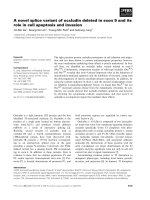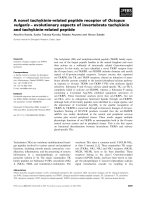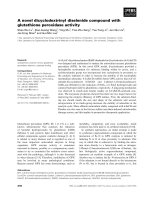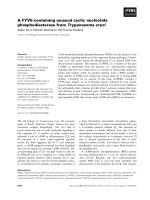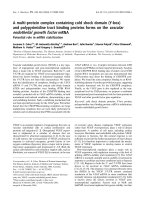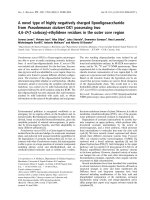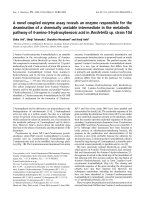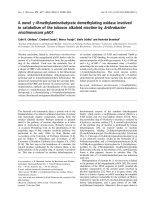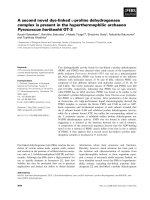Tài liệu Báo cáo Y học: A novel, inducible, citral lyase purified from spores of Penicillium digitatum docx
Bạn đang xem bản rút gọn của tài liệu. Xem và tải ngay bản đầy đủ của tài liệu tại đây (280.86 KB, 8 trang )
A novel, inducible, citral lyase purified from spores
of
Penicillium digitatum
Wout A. M. Wolken
1
, Willem J. V. Van Loo
1
, Johannes Tramper
2
and Marie¨ t J. van der Werf
1,3
1
Division of Industrial Microbiology, Department of Food Technology and Nutritional Sciences, Wageningen University,
the Netherlands;
2
Department of Food Technology and Nutritional Sciences, Wageningen University, Wageningen, the Netherlands;
3
Department of Applied Microbiology and Gene Technology, TNO Food, Zeist, the Netherlands
A novel lyase, combining hydratase and aldolase activity,
that converts citral into methylheptenone and acetaldehyde,
was purified from spores of Penicillium digitatum.Remark-
ably, citral lyase activity was induced 118-fold by incubating
nongerminating spores with the substrate, citral. This
cofactor independent hydratase/aldolase, was purified and
found to be a monomeric enzyme of 31 kDa. Citral lyase has
a K
m
of 0.058 m
M
and a V
max
of 52.6 UÆmg
)1
.Enzyme
activity was optimal at 20 °C and pH 7.6. The enzyme has a
strong preference for the trans isomer of citral (geranial).
Citral lyase also converts other a,b-unsaturated aldehydes
(farnesal, methyl-crotonaldehyde, decenal and cinnemalde-
hyde).
Keywords: hydratase/aldolase; induction; a,b-unsaturated
aldehydes; spores; Penicillium digitatum.
The linear monoterpene citral was originally reported to
occur in lemongrass, accounting for up to 75% of the oil.
Citral was then also found in several other plant oils, e.g. in
lemon and lime oil. Commercial citral is obtained by
isolating it from citral-containing essential oils or by
chemical synthesis from b-pinene or isoprene [1]. Citral is
a mixture of the cis-andtrans-isomers of 3,7-dimethyl-2,6-
octadiene-1-al, referred to as neral and geranial, respect-
ively. Commercial citral typically contains 60% geranial and
40% neral. Citral is widely used in the flavour and fragrance
industry, its application ranges from meat products to hard
candy. The amounts used in the products differ from
0.20 p.p.m. in cheese to 429.8 p.p.m. in chewing gum. Citral
has a strong, lemon-like odour and a characteristic bitter-
sweet taste [1]. With an annual world consumption of 1200
tons (in 1996) it is one of the most applied flavour
compounds [2]. Moreover, citral has antimicrobial [3] and
pheromone activity [4,5], and is used in the production of
vitamin A and ionones [6].
The biotransformation of citral by several organisms
has been described, e.g. in bacteria [7], yeasts [8], fungi [9],
plants [10] and mammals [11]. A pathway for the
transformation of citral into methylheptenone by Botrytis
cinerea was postulated by Brunerie et al.[12].Inthis
pathway citral is first converted into the alcohol then into
the acid, which, after carboxylation is converted into
methylheptenone. Recently we described the biotransfor-
mation of citral in spores of P. digitatum [13]. Citral is
converted into methylheptenone and acetaldehyde by the
action of a single enzyme, citral lyase (Fig. 1A). We now
report on the induction, purification and properties of this
novel enzyme.
MATERIALS AND METHODS
Materials
Acetaldehyde (ethanal), hexadienal (2,4-hexadien-1-al),
hexenal (trans-2-hexenal) and geranylacetone (6,10-dime-
thyl-5,9-undecadien-2-one) were purchased from Aldrich
(Steinheim, Germany). Benzaldehyde was purchased from
Merck (Darmstadt, Germany).
Cinnemaldehyde (trans-cinnamaldehyde), crotonalde-
hyde, decenal (trans-2-decenal) and decadienal (trans,
trans-2,4-decadienal) were purchased from Acros (Geel,
Belgium). Citral (mixture of cis-andtrans-3,7-dimethyl-2,6-
octadien-1-al), methylcrotonaldehyde (3-methylcrotonalde-
hyde), methylheptenone (6-methyl-5-hepten-2-one) and
octanal (caprylic aldehyde) were purchased from Fluka
(Buchs, Switzerland). Farnesal (3,7,11-trimethyl-2,6,10-
dodecatrienal) was purchased from Frinton Laboratories
(Vineland, New Jersey, USA). All other chemicals used were
of analytical grade (purity ‡ 99%).
P. digitatum
and production of spores
P. digitatum ATCC 201167 (P. digitatum CLE) was isolated
from a spoiled tangerine [14]. The culture was maintained as
a spore suspension stored at )80 °C. Spores were obtained
by growing P. digitatum for 8 days (25 °C) on a defined
mineral salts agar (pH 7.0) with asparagine as N-source and
glucose as C-source [13]. Spores were harvested by washing
the surface of the agar with buffer, and, after concentration,
spores were stored at )20 °C until use [13].
Induction of citral lyase activity in spores
Optimization of induction. To a series of 1 mL spore
suspension [7.70 mgÆmL
)1
spores in 50 m
M
phosphate
buffer, pH 7.0 containing 0.1% (v/v) Tween 80
TM
]ina
Correspondence to W. A. M. Wolken, Division of Industrial
Microbiology, Department of Food Technology and Nutritional
Sciences, Wageningen University and Research Centre,
PO Box 8129, 6700 EV Wageningen, the Netherlands.
Fax: + 31 317 484978, Tel.: + 31 317 483393.
E-mail:
(Received 2 August 2002, revised 5 October 2002,
accepted 15 October 2002)
Eur. J. Biochem. 269, 5903–5910 (2002) Ó FEBS 2002 doi:10.1046/j.1432-1033.2002.03312.x
15-mL vial fitted with a Teflon closure, different concen-
trations of citral (1.11 m
M
intervals) were added. The vials
were placed in a shaking waterbath (2.5 Hz, amplitude
2cm,25°C) for different periods of time (4 h intervals).
Subsequently, spores were washed by removal of the
supernatant after centrifugation (2 min, 13 000 g,4°C)
and activity was determined after resuspending the spores
four times in fresh buffer (see activity measurements).
Standard induction. Routinely, citral lyase was induced by
incubating spores with 2.23 m
M
citral for 16 h in 50 m
M
phosphate buffer (pH 7.0) containing 0.1% (v/v)
Tween 80
TM
(2.5 Hz, 2 cm amplitude, 25 °C).
Enzyme purification
All purification steps were carried out, unless stated
otherwise, at 4 °C using buffer containing 50 m
M
potassium
phosphate (pH 7.0), 1 m
M
EDTA and 20% (v/v) glycerol.
Preparation of crude spore extract. Spore-free extract was
prepared by adding an equal volume of glass beads
(fi ¼ 0.5–0.75 mm) to 1 mL aliquots of thawed spore
suspension and subsequent breaking of the spores with a
Retsch (Haan, Germany) model MM 2000 bead mill
(6 min, 1.580 r.p.m., 4 °C).Celldebriswasremovedby
centrifugation at 13 000 g for 10 min. The supernatant was
used as the crude spore extract.
Hydroxyapatite and anionexchange chromatography.
Crude spore extract was diluted to a concentration of
10 m
M
phosphate buffer and applied to a HA (hydroxy-
apatite, Bio-Rad) column (5 · 6 cm) equilibrated with the
same buffer, at a rate of 0.3 mLÆmin
)1
.Thecolumnwas
subsequently washed with 100 mL of the same buffer.
Unbound fractions (containing the citral lyase activity) were
directly applied to a DEAE-Sepharose CL-6B (Pharmacia)
column (2.5 · 25 cm), equilibrated with the same buffer.
Protein was eluted by a phosphate buffer gradient: 10 m
M
(180 mL), 10–94 m
M
(495 mL, linear), 94–250 m
M
(90 mL,
linear) and 250 m
M
(90 mL), at a rate of 0.9 mLÆmin
)1
(collected fraction volume, 9 mL). Fractions containing
citral lyase activity (31–46 m
M
phosphate buffer) were
pooled. HA and DEAE were both operated with a Gradifac
system (Pharmacia Biotech, Roosendaal, the Netherlands).
Concentration and gelfiltration chromatography. After
HA/DEAE active fractions were concentrated (on ice) in an
Amicon ultrafiltration unit using a YM-10 membrane at
5 bar of pressure. The concentrated fractions were loaded
onto an analytical G75 gelfiltration column (Superdex
FPLC, Pharmacia Biotech, Roosendaal, the Netherlands)
equilibrated with buffer [50 m
M
potassium phosphate,
pH 7.0, 1 m
M
EDTA and 20% (v/v) glycerol]. The enzyme
was eluted at 1 mL min
)1
using a FPLC system (Pharma-
cia, Roosendaal, the Netherlands) at room temperature.
Activity measurements
Citral lyase activity was typically determined by incubating
the sample [1 mL total volume in a 15-mL vial fitted with
Teflon Mininert valves (Supelco, Zwijndrecht, the Nether-
lands)] with citral, in a shaking water bath (oscillating at
2.5 Hz with an amplitude of 2 cm). Unless stated, the
incubations were carried out for 15 min at 25 °Cata
substrate concentration of 0.5 m
M
after which liquid
samples were taken and analysed for methylheptenone
(see analytical methods). The standard buffer used con-
tained 50 m
M
potassium phosphate buffer (pH 7.0), 1 m
M
EDTAand20%(v/v)glycerol.Oneunitofcitrallyase
activity was defined as the amount of enzyme that produces
1 lmol of methylheptenone or acetaldehyde per min.
Activity in spores. Citral lyase activity of spores was
determined by diluting the spore suspensions 50 times in
buffer (50 m
M
phosphate buffer, pH 7.0 containing 0.1%
(v/v) Tween 80
TM
) and incubated for 30 min with 2.83 m
M
citral.
Stability of citral lyase. The crude spore extract was
diluted (1–100 times) and stored (0–7 days) at 4 °C. To
determine activity all samples were diluted 100 times and
1.1 m
M
citral was added.
Conversion profile of citral. The conversion of citral was
followed in time by taking headspace samples from 2 to
60 min at 2-min intervals to determine acetaldehyde
production and liquid samples in time to determine
methylheptenone formation and geranial and neral degra-
dation.
V
max
and K
m
. The V
max
and K
m
were determined by
measuring acetaldehyde during the conversion of different
concentrations of citral (0.022–0.556 m
M
). The initial
activities of the conversions were plotted in a Lineweaver–
Burk plot to obtain the value V
max
and K
m
.
Temperature and pH optimum. The temperature depend-
ence of the conversion was determined by varying the
temperature during the incubation from 0.4 to 45 °C.
The pH dependence of the conversion was determined by
varying the pH form 5.66–10.19 (by adding 0.8 mL of 0.1
M
buffer to 0.2 mL of purified enzyme). The exact pH during
Fig. 1. Reaction catalysed by citral lyase, combining hydratase and
aldolase activity (A), from P. digitatum and other (B) and (C) hydratase/
aldolase enzymes described in literature. (B1) enoyl-CoA hydratase/
aldolase [26]; (B2) trans-o-hydroxybenzylidenepyruvate hydratase/al-
dolase [29]; (B3) trans-2-carboxybenzalpyruvate hydratase/aldolase
[32]; (C) 6-hydroxy-2-keto-5-methyl-3,5-heptadienoic acid hydratase/
aldolase [33].
5904 W. A. M. Wolken et al. (Eur. J. Biochem. 269) Ó FEBS 2002
the conversion was determined using a WTW microproces-
sor pH meter (Weilheim, Germany).
Alternative substrates. The conversion of the different
substrates was tested using acetaldehyde production in time
as a measure for activity. At the end of the conversion liquid
samplesweretakenandanalysedbyGCandGC-MSto
determine the products formed.
Electrophoresis
SDS/PAGE was used to assess purity of enzyme prepara-
tions and determine the molecular mass of the purified
enzyme under denaturing conditions. SDS/PAGE was
carried out with a Bio-Rad apparatus (mini protean II)
and a homogenous 15% polyacrylamide gel, using Coo-
massie blue staining for detecting protein bands. Prestained
protein markers (Bio-Rad) in the 7100–209 000 molecular
mass range were used to estimate molecular mass. The gel
was scanned using a Bio-Rad GS-710 Calibrated Imaging
Densitometer and interpreted using the
QUANTITY ONE
software (version 4.2.1).
Analytical methods
Substrates and products of the conversions were detected by
extracting the liquid samples with ethyl acetate and
subsequent GC and GC-MS analysis, as described earlier
[13]. Acetaldehyde and acetone were determined in the
headspace of the samples as described earlier for acetalde-
hyde, only now isocratically at an oven temperature of
60 °C [13]. Protein concentrations of spore suspensions and
spore extracts were determined according to Lowry [15]
using bovine serum albumin as the standard.
RESULTS
Induction of citral lyase
Initially, the reproducibility of the results was hindered by
variations in the citral lyase activity of the P. digitatum
spores. Remarkably, lyase activity was found to be induced
when spores were incubated with the substrate, citral.
Induction of citral lyase activity in spores of P. digitatum
was dependent on both the concentration of citral and the
time of induction (Fig. 2). Preincubation of the spores with
citral for 12 h resulted in a substantial increase in lyase
activity. Longer incubation times did not result in a further
increase of activity. The induction was also strongly
dependent on the citral concentration; while there was no
induction in the absence of citral, the activity of the induced
spores increased strongly with citral concentration reaching
a maximum at a concentration of 2.2 m
M
. Raising the citral
concentration to above 3.3 m
M
lead to a dramatic decrease
in activity because of the toxic effects of citral towards
spores of P. digitatum described earlier [16]. For optimal
induction of citral lyase activity, spores should be incubated
for at least 12 h at a citral concentration of between 1.7 and
2.8 m
M
. Under these conditions the average activity of the
induced spores was 204 nmolÆmin
)1
Æmg
)1
,whichisafactor
of 118 higher than the activity of the noninduced spores
(1.7 nmolÆmin
)1
Æmg
)1
). Addition of 0.05% (v/v)
1
of cyclo-
hexamide, a protein synthesis inhibitor [17], inhibited the
induction of citral lyase completely. The addition of
cyclohexamide after induction did, however, not negatively
influence citral lyase activity (not shown). This indicates that
citral lyase is induced and not activated. To check for
germination, the spores were studied under a light micro-
scope (400 times magnification). There was no appreciable
germtube-formation (less than 1 in 1000 spores showed
signs of germination) visible during the induction, not even
after 40 h. Furthermore, the total protein content and
average spore size did not change during induction.
Stability of citral lyase activity
The activity and stability of citral lyase was dramatically
affected by the addition of 20% (v/v) glycerol and 1 m
M
EDTA. When glycerol and EDTA were added before
disrupting the spores, the activity of the crude spore extract
was more than 25-fold higher (not shown). Even when these
compounds were added after preparation of the crude spore
extract there was a strong positive effect on the activity.
Crude spore extract was found to be stable, only minor loss
of activity was observed at 4 °C over a period of 7 days
(Fig. 3A). However, dilution of crude spore extract resulted
in a reduced stability of citral lyase (Fig. 3B). Upon 100
times dilution of the spore extract, 79% of activity was lost
in 1 day. Even at 10 times dilution 56% of activity was lost.
Fig. 2. Induction of citral lyase activity in spores of P. digitatum
(7.70 mgÆmL
)1
) using different combinations of citral concentration and
incubation time. Specific activity was calculated from the methyl-
heptenone produced in 30 min.
Ó FEBS 2002 Citral lyase from P. digitatum (Eur. J. Biochem. 269) 5905
The stability of citral lyase proved to be a key problem in
further purification of citral lyase (see below).
Enzyme purification
Of several different methods tested, hydroxyapatite (HA)
and anionexchange (DEAE) chromatography were the
most effective purification steps for citral lyase. Although
citral lyase did not bind to HA it was an effective
purification step as more than three-quarters of the total
protein did bind to the HA column (not shown). To limit
the negative effects of dilution, the HA column was directly
coupled to the DEAE column. Previously, we showed that
citral lyase has a low affinity for DEAE [13]. Simply raising
the phosphate buffer concentration was sufficient to elute
the enzyme, thus avoiding the use of NaCl or KCl, that have
negative effects on stability of the enzyme (results not
shown). Using HA and DEAE citral lyase was purified 21-
fold with an overall yield of 7% (Table 1). Final purification
by gelfitration resulted in a substantial loss of activity. This
is in part caused by the need to concentrate the partially
purified enzyme before applying it to the column and in part
by the fact that gelfiltration was carried out at room
temperature. Therefore, inclusion of the gelfiltration step in
the overall purification scheme resulted in a reduced
purification factor
2
and a very poor yield (Table 1). Because
of the large loss of activity in the final purification step the
citral lyase characterization studies were done with the citral
lyase preparation after HA and DEAE.
SDS/PAGE of the enzyme after final purification
revealed one distinct band (Fig. 4 lane 3). This band
corresponds to one of the three major bands obtained after
HA/DEAE purification visible in lane 2 of the same figure.
From the gel it was calculated that the enzyme after HA and
DEAE is 11.3% pure.
The native molecular mass of citral lyase was determined
to be 25 kDa, based on the elution pattern of citral lyase
activity during gelfiltration as compared to molecular mass
standards. SDS/PAGE revealed a molecular mass of
30.8 kDa under denaturing conditions (Fig. 4). Based on
these results it can be concluded that citral lyase is a
monomeric enzyme of approximately 30 kDa.
Citral conversion
The conversion of citral by citral lyase was followed in time
(Fig. 5). Citral lyase has a strong preference for the trans
isomer of citral (geranial). Whereas geranial was already
converted for approximately 45% after 60 min no neral (the
cis isomer of citral) is converted at all. However, once the
geranial concentration approaches zero also neral is
converted albeit with approximately half the conversion
rate as compared to geranial (insert Fig. 5). Citral is
converted into equimolar amounts of methylheptenone
and acetaldehyde.
Table 1. Purification of citral lyase from spores of P. digitatum.
Fraction
Total Activity
(U)
Total Protein
(mg)
Specific activity
(UÆmg
)1
)
Purification
(– fold)
Recovery
(%)
Noninduced spore extract 0.00052
Induced spore extract 27.7 23.5 1.18 1 100
Combined HA/DEAE 2.03 0.081 25.2 21.4 7.3
Gelfiltration (G75) 0.009 0.008 1.1 0.9 0.03
Fig. 3. Stability of citral lyase activity in crude spore extract of
P. digitatum . Activity was determined as methylheptenone formation
after a 15-min incubation; the initial activity (storage time 0 days) was
set to 100%. (A) Effect of storage at 4 °C on undiluted crude spore
extract (1.8 mg mL
)1
). (B) Effect of dilution on activity after 1 day
storage at 4 °C.
Fig. 4. SDS/PAGE of citral lyase from P. digitatum. M, molecular
mass markers (6.25 lg); 1, Crude spore extract (10.7 lg);2,pooled
fractions after HA/DEAE (3.9 lg); 3, pooled fractions after gelfiltra-
tion (0.3 lg); CL, citral lyase.
5906 W. A. M. Wolken et al. (Eur. J. Biochem. 269) Ó FEBS 2002
The citral conversion rate was determined at different
citral concentrations. From the Lineweaver–Burk plot of
these data, the K
m
for citral conversion was determined to
be 0.058 (± 0.01) m
M
and the V
max
of the conversion was
52.6 (± 6.7) UÆmg
)1
.
Temperature and pH optimum
The temperature dependence of citral lyase is shown
Fig. 6A. Lyase activity is approximately 50% of maximum
at 8 °C and rises gradually to a clear optimum at 20 °Cafter
which it gradually declines again, reaching 50% activity at
30 °C. From the Arrhenius plot (insert Fig. 6A) an
activation energy of citral conversion of 47.2 kJÆmol
)1
for
citral lyase activity was determined. The activation energy
for the inactivation of the enzyme was determined to be
103.3 kJÆmol
)1
.
The pH dependence of citral conversion by the purified
enzyme is shown in Fig. 6B. The activity is approximately
50% of maximum at pH 6.5 and rises gradually to a clear
optimum at a pH of 7.6 after which it declines reaching 50%
activity at pH 8.2. The buffer used had a significant effect
on the citral lyase activity, and the highest activities were
found using potassium phosphate buffer. At pH 7.0 five
other buffers were tested (Mes/NaOH, Hepes/NaOH, Tris/
maleate, Imidazole/HCl and Mops/KOH), which all resul-
ted in lower (5–25 times) activities compared to potassium
phosphate buffer (not shown).
Substrate specificity
Arangeofa,b-unsaturated aldehydes were tested as
substrates for citral lyase (Table 2). As the total activity of
the partially purified citral lyase is relatively low (Table 1)
crude spore extract was used to pre screen potential
substrates. Farnesal was converted with a rate of 30.6%
of that of citral whilst methyl-crotonaldehyde, decenal and
cinnemaldehyde were converted to a lesser extent, with 0.6,
0.7 and 0.3%, respectively. Conversion of crotonaldehyde,
hexenal, hexadienal and decadienal was not observed.
Retinaldehyde was also not converted by the crude spore
extract. This was probably because retinaldehyde does not
dissolve well in aqueous media and the addition of a
cosolvent (10% acetone or ethanol) led to the total loss
of enzyme activity. Previously we showed that citral [18]
and other a,b-unsaturated aldehydes (W.A.M. Wolken,
J. Tramper & M.J. van der Werf, unpublished data)
3
are also
converted chemically, albeit at higher pH. As a control for
this chemical (and nonspecific enzymatic) conversion non-
induced crude spore extract (0.05% of citral conversion
activity as compared to extracts of induced spores) was
used. These controls did not show detectable conversion of
the alternative substrates.
After the screening conversion of farnesal, methyl-
crotonaldehyde, decenal and cinnemaldehyde by HA/
DEAE purified citral lyase was tested, this resulted in
similar results. Farnesal, which structurally resembles citral
the most of the tested substrates, is converted fastest by
citral lyase (20.6% as compared to citral). GC and GC-MS
showed that farnesal is converted to form the aroma
compound geranyl acetone. The citral lyase also converted
methyl-crotonaldehyde and decanal forming acetone and
octanal, respectively. Furthermore, cinnemaldehyde was
converted into benzaldehyde, one of the most frequently
applied flavour compounds [1].
DISCUSSION
In this study, we purified citral lyase from spores of
P. digitatum. Presently, only a very limited number of
reports describing the purification of enzymes from spores
have been published. These reports describe enzymes
Fig. 5. Transformation of citral into methylheptenone and acetaldehyde
by purified citral lyase after HA/DEAE (0.221 lgÆmL
)1
). Insert, con-
version of citral by crude spore extract (36.7 lgÆmL
)1
). Symbols: d,
geranial, j,neral,r, acetaldehyde, and m, methylheptenone.
Fig. 6. Effect of temperature (A, insert, Arrhenius plot) and pH (B) on
activity of citral lyase. Activity was based on methylheptenone pro-
duction by purified citral lyase after HA/DEAE (0.221 lgÆmL
)1
). (A)
50 m
M
phosphate buffer (pH 7.0), (B) 25 °C, Potassium phosphate
buffer (r) and sodium carbonate/sodium bicarbonate buffer (j).
Ó FEBS 2002 Citral lyase from P. digitatum (Eur. J. Biochem. 269) 5907
Table 2. Conversion of a,b-unsaturated aldehydes by citral lyase from spores of P. digitatum.
Relative activity (%)
Substrate Crude spore extract
Citral lyase
after HA/DEAE Product
Name Structure Induced Noninduced Induced Noninduced Name Structure Identification method
Citral
100
a
< 0.1 100
a
< 1.0 Methylheptenone GC; GC-MS
Methyl-crotonaldehyde
0.6 < 0.1 1.9 < 1.0 Acetone GC
Farnesal
30.6 < 0.1 20.6 < 1.0 Geranyl acetone GC-MS
Retinaldehyde
< 0.1 < 0.1
Crotonaldehyde
< 0.1 < 0.1
Hexenal
< 0.1 < 0.1
Decenal
0.7 < 0.1 3.6 < 1.0 Octanal GC
Cinnemaldehyde
0.3 < 0.1 1.6 < 1.0 Benzaldehyde GC
Hexadienal
< 0.1 < 0.1
Decadienal
< 0.1 < 0.1
a
Set to 100% for crude spore extract and purified enzyme, respectively.
5908 W. A. M. Wolken et al. (Eur. J. Biochem. 269) Ó FEBS 2002
purified from fungal (e.g. Neurospora crassa [19] and
Botrytis cinerea [20]) as well as bacterial spores (e.g.
Clostridium perfringens [21] and Bacillus subtilis [22]). There
are several reasons to purify an enzyme from spores rather
than from vegetative cells or mycelium. The enzyme of
interest might be part of the germination machinery of the
spores, and thus only present in spores [21]. Likewise, some
bioconversion activities are only present in the spores, as
was demonstrated for Saccharomyces cerevisiae and Bacillus
subtilis [23]. Furthermore, there can be differences in the
biochemical properties of enzymes expressed in spores as
compared to vegetative cells [19]. It has been reported that
some enzymes are modified from vegetative type to spore
type by a sporulation-specific protease during sporulation,
producing differences in molecular and/or catalytic proper-
ties [24]. Citral lyase, which was first identified in spores of
P. digitatum, was also expressed in mycelium (not shown).
However, due to the higher susceptibility of mycelium
towards the toxic effects of citral [16] the enzyme could only
be induced by a factor of 5 in mycelium (not shown) as
compared to the factor 118 induction in spores.
Remarkably, citral lyase could be induced in the nonger-
minating spores of P. digitatum. To the best of our
knowledge, the induction of an enzymatic activity in
nongerminating spores has so far only been described in
spores of Aspergillus oryzae,i.e.a-amylase, invertase and
glucose dehydrogenase were induced in spores of A.oryzae
without the occurrence of germination or swelling [25].
The most probable mechanism for the conversion of
citral into methylheptenone and acetaldehyde is the addition
of water to the a,b-double bond resulting in 3-hydroxyci-
tronellal followed by rearrangement of the hydroxyl group
leading to the cleavage of the a,b C-C bond (Fig. 1A).
This pathway is analogous to that proposed for the
amino acid catalysed conversion of citral at high pH [18].
For the enzymatic equivalent of this reaction the actions
of a hydratase and an aldolase are needed. Citral lyase
of P. digitatum combines hydratase and aldolase activity
in a single enzyme. No other enzyme has been reported
to catalyse the conversion of citral into methylheptenone
and acetaldehyde, or a similar conversion of other
a,b-unsaturated aldehydes. However, there have been
reports on enzymes combining the action of a hydratase
with that of an aldolase. The best studied is enoyl-CoA
hydratase/aldolase [26] (also known as 4-hydrox-
ycinnamoyl-CoA hydratase/aldolase [27]), which is involved
in the bioconversion of ferulic acid to vanillin (Fig. 1B1).
Besides the substrate (feruloyl-CoA), enoyl-CoA hydratase/
aldolase also convert the proposed intermediate (4-hydroxy-
3-methoxyphenyl-b-hydroxypropionyl-CoA) into vanillin
[28]. An other well known example is trans-o-hydroxy-
benzylidenepyruvate hydratase/aldolase [29,30] (also known
as is 2¢-hydroxybenzalpyruvate hydratase/aldolase [31]),
which is part of the naphthalene catabolic pathway (Figs 1
and 2). Furthermore, trans-2-carboxybenzalpyruvate
hydratase/aldolase [32] (Fig. 1B3) and 6-hydroxy-2-keto-
5-methyl-3,5-heptadienoic acid hydratase/aldolase [33]
(Fig. 1C) have been reported in literature. Four hydra-
tase/aldolases, which (like citral lyase cofactor) are inde-
pendent, have been purified and characterized. One is a
homodimer of 63 kDa [27], the other three were all
homotrimers of 110 [30], 113 [32] and 120 kDa [31],
respectively. Citral lyase is a monomeric enzyme of
30 kDa, which is approximately the monomeric size of
these hydratase/aldolase enzymes. All of these enzymes
exhibit more then 75% of their maximum activity at pH 7.6,
the optimum pH of citral lyase [27,30–32]. Whereas, many
bacterial aldolases require a divalent cation for catalysis, this
does not seem to be the case for hydratase/aldolases,
which are, like citral lyase, not negatively affected by EDTA
[32].
The citral lyase described in this paper is the first example
of a hydratase/aldolase acting on the a,b-double bond of
a,b-unsaturated aldehydes. This novel enzyme was purified
from spores of P. digitatum, wherein it was found to be
inducible by the substrate citral. Citral lyase seems to have
the potential to produce other natural flavour compounds
as, e.g. benzaldehyde.
ACKNOWLEDGEMENT
This work was supported by grant FAIR CT 98-3559 from the
European Community. We thank Ben van den Broek for helping with
interpretation of the SDS/PAGE gel.
REFERENCES
1. Burdock, G.A. (2002) Fenaroli’s Handbook of Flavor Ingredients,
4rd edn. CRS Press, Boca Raton.
2. Somogyi, L. (1996) The flavour and fragrance industry: serving a
global market. Chem. Ind. 170–173.
3. Onawunmi, G.O. (1989) Evaluation of the antimicrobial activity
of citral. Lett. Appl. Microbiol. 9, 105–108.
4. Kuwahara, Y., Suzuki, H., Matsumoto, K. & Wada, Y. (1983)
Pheromone study on acarid mites. XI. Function of mite body
as geometrical isomerization and reduction of citral (the
alarm pheromone) Carpoglyphus lactis. Appl. Entomol. Zool. 18,
30–39.
5. Robacker, D.C. & Hendry, L.B. (1977) Neral and geranial:
components of the sex pheromone of the parasitic wasp, Itoplectis
conquisitor. J. Chem. Ecol. 3, 563–577.
6. Shadab, Q., Hanif, M. & Chaudhary, F.M. (1992) Antifungal
activity by lemongrass essential oils. Pak. J. Sci. Ind. Res. 35, 246–
249.
7. Joglekar, S.S. & Dhavlikar, R.S. (1969) Microbial transformation
of terpenoids. I. Indentification of metabolites produced by a
Pseudomonad from citronellal and citral. Appl. Microbiol. 18,
1084–1087.
8. Chatterjee, T., B.K. & Bhattacharyya, D.K. (1999) Bioconve-
rsions of citral and (+/-)-citronellal by Saccharomyces
cerevisae-2415. Indian J. Chem. B Org. Chem. Inc. Med. Chem. 38,
1025–1029.
9. Demyttenaere, J.C.R. Herra, M.D.C. Kimpe, N. d. (2000)
Biotransformation of geraniol, nerol and citral by sporulated
surface cultures of Aspergillus niger and Penicillium sp. Phyto-
chemistry 55, 363–373.
10. Dudai, N., Larkov, O., Putievsky, E., Lerner, H.R., Ravid, U.,
Lewinsohn, E. & Mayer, A.M. (2000) Biotransformation of con-
stituents of essential oils by germinating wheat seed. Phytochem-
istry 55, 375–382.
11. Ishida, T., Toyota, M. & Asakawa, Y. (1989) Terpenoid
biotransformation in mammals. V. Metabolism of (dextro)-
citronellal, (racemic) -7-hydroxycitronellal, citral, (levo)-
perillaldehyde, (levo)-myrtenal, cuminaldehyde, thujone, and
(racemic)-carvone in rabbits. Xenobiotica. 19, 843–856.
12. Brunerie, P., Benda, I., Bock, G. & Schreier, P. (1988) Bio-
conversion of monoterpene alcohols and citral by Botrytis cinerea.
In Bioflavour Ô87 (Schreier, P., ed.), pp. 435–444. Walter de
Gruyter, Berlin.
Ó FEBS 2002 Citral lyase from P. digitatum (Eur. J. Biochem. 269) 5909
13. Wolken, W.A.M. & van der Werf, M.J. (2001) Geraniol bio-
transformation-pathway in spores of Penicillium digitatum. Appl.
Microbiol. Biotechol. 57, 731–737.
14. Demyttenaere, J.C.R. & DePooter, H.L. (1998) Biotransforma-
tion of citral and nerol by spores of Penicillium digitatum. Flavour
Fragrance J. 13, 173–176.
15. Lowry, O.H., Rosebrough, N.J., Farr, A.L. & Randall, R.J.
(1951) Protein measurement with the Folin phenol reagent. J. Biol.
Chem. 193, 265–275.
16. Wolken, W.A.M., Tramper, J. & van der Werf, M.J. (2002)
Toxicity of terpenes to spores and mycelium of Penicillium digi-
tatum. Biotechnol. Bioengineer 80, 685–690.
17. Santos, T., Villanueva, J.R. & Nombela, C. (1978) Regulation of
beta-1,3-glucanase synthesis in Penicillium italicum. J. Bacteriol.
133, 541–548.
18. Wolken, W.A.M., ten Have, R. & van der Werf, M.J. (2000)
Amino acid-catalyzed conversion of citral: cis-trans isomerization
and its conversion into 6-methyl-5-hepten-2-one and acet-
aldehyde. J. Agric. Food. Chem. 11, 5401–5405.
19. Say,J.C.,Furriel,R.P.M.,Ciancaglini,P.,Jorge,J.A.,Lourdes,
M., Polizeli, T.M., Pizauro, J.M., Terenzi, H.F. & Leone, F.A.
(1996) Conidial alkaline phosphatase from Neurospora crassa.
Phytochemistry 41, 71–75.
20. Gindo, K. & Pezet, R. (1999) Purification and characterization of
a 40.8-kDa cutinase in ungerminated conidia of Botrytis cinerea
Pers. Fr. FEMS Micro. Biol. Lett. 171, 239–243.
21. Miyata, S., Moriyama, R., Sugimoto, K. & Makino, S. (1995)
Purification and partial characterization of a spore cortex-lytic
enzyme of Clostridium perfringens S40 spores. Biosci. Biotechn
Biochem. 59, 514–515.
22. Suzuki, S.I., Izawa, Y., Kobayashi, K., Eto, Y., Yamanaka, S.,
Kubota, K. & Yokozeki, K. (2000) Purification and character-
ization of novel transglutaminase from Bacillus subtilis spores.
Biosci. Biotechnol. Biochem. 64, 2344–2351.
23. Murata, K. (1993) Use of microbial spores as a biocatalyst. Crit.
Rev. Biotechnol. 13, 173–193.
24. Ujita, S. & Kimura, K. (1975) Studies of glucose metabolism in
Bacillus subtilis. I. Purification of glucose-6-phosphate dehy-
drogenase from the vegetative cell and its properties in comparison
with the spore enzyme. J. Biochem. 77, 197–206.
25. Sinohara, H. (1970) Induction of enzymes in dormant spores of
Aspergillus oryzae. J. Bacteriol. 101, 1070–1072.
26. Overhage, J., Priefert, H. & Steinbuchel, A. (1999) Biochemical
and genetic analyses of ferulic acid catabolism in Pseudomonas sp
strain HR199. Appl. Environ. Microbiol. 65, 4837–4847.
27. Mitra, A., Kitamura, Y., Gasson, M.J., Narbad, A., Parr, A.J.,
Payne, J., Rhodes, M.J.C., Sewter, C. & Walton, N.J. (1999)
4-hydroxycinnamoyl-CoA hydratase/lyase (HCHL) -An enzyme
of phenylpropanoid chain cleavage from Pseudomonas. Arch.
Biochem. Biophys. 365, 10–16.
28. Gasson, M.J., Kitamura, Y., Russell McLauchlan, W., Narband,
A., Parr, A.J., Parsons, E.L.H., Payne, J., Rhodes, M.J.C. &
Walton, N.J. (1998) Metabolism of ferulic acid to vanillin: a
bacterial gene of the enoyl-SCoA hydratase/isomerase super-
family encodes an enzyme for the hydration and cleavage of
hydroxycinnamic acid SCoA thioester. J. Biol. Chem. 273,
4163–4170.
29. Eaton, R.W. (1994) Organization and evolution of naphthalene
catabolic pathways: sequence of the DNA encoding 2-hydroxy-
chromene-2-carboxylate isomerase and trans-o-hydroxybenzy-
lidenepyruvate hydratase-aldolase from the NAH7 plasmid.
J. Bacteriol. 176, 7757–7762.
30. Ohmoto, T., Moriyoshi, K., Sakai, K., Hamada, N. & Ohe, T.
(2000) Presence of two trans-o-hydroxybenzylidenepyruvate
hydratase-aldolases in naphthalenesulfonate-assimilating Sphin-
gomonas paucimobilis TA-2: comparison of some properties.
J. Biochem. 127, 43–49.
31. Kuhm, A.E., Knackmuss, H.J. & Stolz, A. (1993) Purification and
properties of 2¢-hydroxybenzalpyruvate aldolase from a bacterium
that degrades naphthalenesulfonates. J. Biol. Chem. 268, 9484–
9489.
32. Iwabuchi, T. & Harayama, S. (1998) Biochemical and genetic
characterization of trans-2¢-carboxybenzalpyruvate hydratase-
aldolase from a phenanthrene-degrading Nocardioides strain.
J. Bacteriol. 180, 945–949.
33. Laurie, A.D. & Lloyd Jones, G. (1999) The phn genes of
Burkholderia sp. strain RP007 constitute a divergent gene
cluster for polycyclic aromatic hydrocarbon catabolism. J. Bac-
teriol. 181, 531–540.
5910 W. A. M. Wolken et al. (Eur. J. Biochem. 269) Ó FEBS 2002

